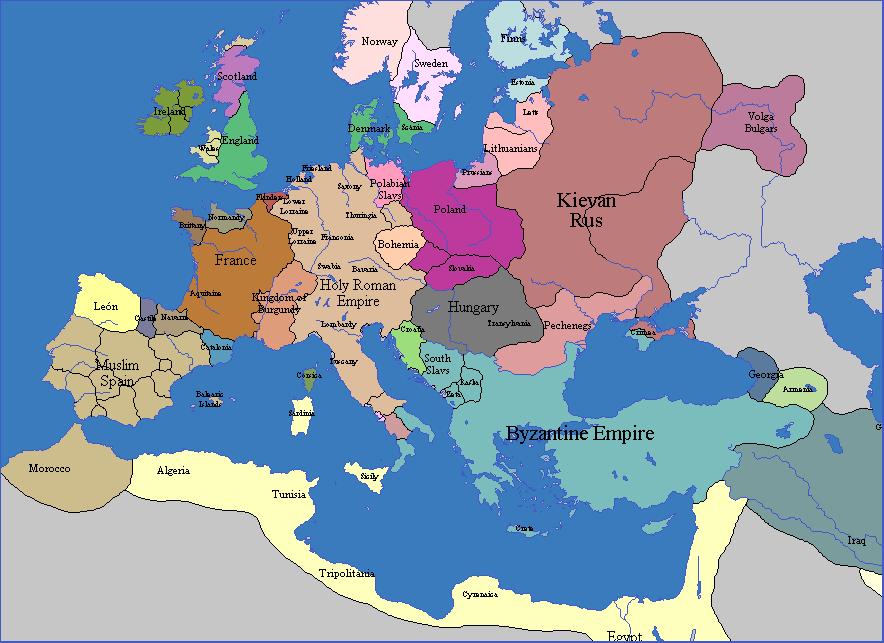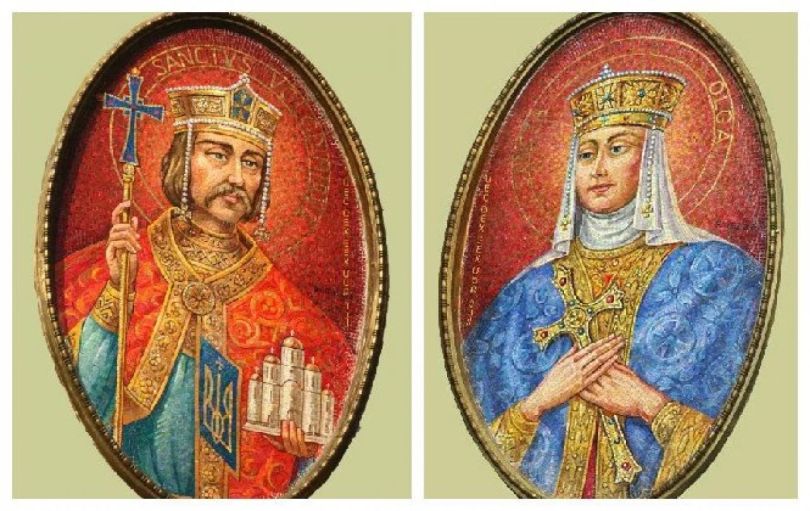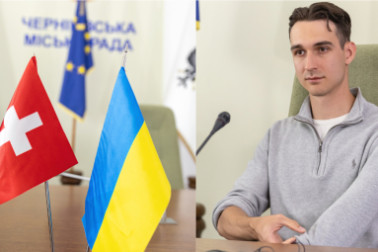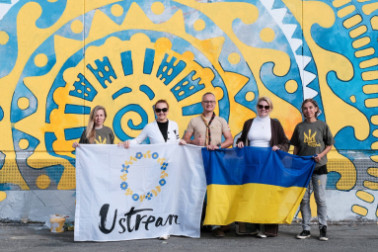
History of Kyivan Rus
It is noteworthy that in the history of Kyivan Rus’ three consecutive periods can be distinguished:
- the period of the nascence, formation and evolution of state structures, chronologically it covers the end of the 9th - the end of the 10th century;
- the period of the greatest rise and development of Kyivan Rus’ (the end of 10th - the middle of 11th century);
- the period of political fragmentation of Kyivan Rus’ (the end of 11th - mid-13th century).
Regarding the history, the princes of Kyivan Rus’ started their story from the legendary prince Kyi who is considered to be the founder of the Ukrainian capital, Kyiv city. Further, Prince Rurik is mentioned, followed by Askhold and Dir, who were boyars of Rurik and conquered Kyiv. They all were brought down by the prince Oleg, by the order of whom Askhold and Dir were killed.
Normanism (Norman theory) in historiography tells that Kyivan Rus has Vikings` roots. The adherers of Norman theory think that the Normans (Varangians) have founded the first states of the Eastern Slavs (Rurik`s state and then Kievan Rus). In 862, the Eastern Slavic tribes approached to the Normans with an offer to rule their lands and to take the prince`s throne (according to “Tale of Bygone Years” chronicles). The Slavic people of the Rus decided to do so in order to stop the internal strives that had been tearing apart Slavic lands. In that way, Prince Rurik became the ruler of Novgorod city and Kyivan Rus people. 
Kyivan Rus Symbolics
Heraldic family emblems - usually bidents and tridents - have begun to appear on the coins, stamps, rings and weapons of the Kyivan Russia rulers since the X century. The first picture of bident as a prince`s symbol dates back to the times of Rurik`s son - Ihor. Ihor`s son Sviatopolk and Sviatopolk`s son Yaropolk continued to use bidents.
As for the flags of Kyivan Rus, they were mostly red-colored because it made them easily recognizable in a battle. However, the great Prince Volodymyr has a special emblem: a golden trident on blue background. Probably Volodymyr`s emblem is a prototype of the modern Ukrainian flag.
It is worth noting that in St. Peter’s Cathedral there is a mosaic depicting St. Volodymyr with a trident. In honor of the millennium of the baptism of Kyivan Rus, it was presented by the Ukrainian Greek Catholic priest Vasily Losten. In the Vatican, symbols of other states are prohibited, except for the Vatican itself. At that time, the trident was considered as a sign of Prince Volodymyr, and not the state emblem.

Thus, modern Ukraine has become the only state in the world whose coat of arms is in the Vatican.
Kyivan Rus Architecture
Before the Christianizing of Rus in 988, the most of buildings here had been built of wood. Wood was used for residential houses as well as for defensive walls. For this reason, ancient Rus houses and fortifications have not survived till our days. Therefore, the history of Kyivan Rus architecture has to be learned starting from the end of the X century when the Rus was Christianized and people began to construct stone buildings. By the way, Desyatynna Church in Kyiv (989) is considered as the first stone church of Kyivan Rus.
Crafts
Kyivan Rus’ was also famous for its art of weapon masters. On the historians assurances, it was on these lands that for the first time a six-aperture, a bracer, a hook for stretching a crossbow, chain mail with flat rings, a steel mask for horses, spurs with a plate-shaped peak and spurs with a wheel, as well as lamellar armor were created. The level of jewelry work of city masters was not inferior to the creations of world art leaders of that era in Byzantium and the Middle East. Specialists in gold and silver affairs sought to improve the effects of light as much as possible, and therefore the silver was blackened and gilded.
Crafting in Rus’ was popular and of a big demand. A skilled potter or blacksmith could serve three or four settlements. Kyivan Rus’ was one of the most "urbanized" countries of Europe at that time: in the 9th -10th centuries there were at least 25 cities, and in the 11th century their number was approaching a hundred. Because of this, in the Scandinavian saga these lands are called Gardarica, a country of cities. The medieval "business" was actively developing - and coins from gold and silver, as well as silver bars - hryvnia, replaced furs in the role of money.
Even before christening in Kyivan Rus’ there were many "storytellers", singers who played the harp, sang songs on heroic subjects - campaigns to Byzantium, the Balkans, battles with the invaders, exploits of the people's heroes. Historians also write about even earlier sorrowful songs, in particular about the tragic fate of the Slavic prince Busa of the 4th century, enslaved in a battle with the Goths and painfully killed by them.
Literature, including chronicles, was also an important element of the culture of Kyivan Rus. In particular, "The Tale of Bygone Years" is the first chronicle that describes the history of Kyivan Rus from ancient times to 1113. This chronicle tells about the arrival of the Varangians, the first princely dynasties, international relations and wars, religious changes, and other events. The first writers also appeared on the lands of Kyivan Rus, including Nestor the Chronicler, who wrote "The Tale of Bygone Years" and other works.
Drinks
When it comes to drinking habits in Kyivan Rus', it's worth noting that vodka did not exist and alcohol was not produced. The main alcoholic beverages were kvass, honey, and wine. Kvass, which was often non-alcoholic or had a low alcohol content, was made from rye bread and resulted in a beer-like drink. A Byzantine traveler from the 5th century even mentioned it, along with honey. After the baptism of Rus', kvass began to be produced in monasteries. Honey was prepared in various ways to cater to different tastes, including dry, sweet, and with pepper. Boiled honey as a drink was of lower quality. However, the most prized honey drink was kept for 10-15 years or more, which was the result of the natural fermentation of bee honey with the juice of forest berries.
Traditions and Religion in Kyivan Rus
Scientists provide a lot of evidences in favor of literacy presence in Kyivan Rus’ long before Cyril and Methodius. In their opinion, local residents wrote "features" and "cuts" - a local version of the runes - with the help of which "they read and guessed." The literacy of the ancient Slavs is also described in Arabic and German sources. Chroniclers reported prophecies on stones, signatures to monuments and a diplomatic mail on "Russian letters".
Introducing family order, prior to christening in the lands of Kyivan Rus’, polygamy prevailed, as a rule, there were from two to four wives. According to historians, there was no strict subordination in the family, moreover, "unloved" wives could openly change their spouses or go to another, who promised more attention and love. Mauritius Strategist, a Byzantine historian of the 6th century, was surprised by one of the intimate practices of the Slavs - making love in the water, on a lake or river bank.
One of the first to resent the free morals of young people was Princess Olha, the first of the powers who accepted Christianity.
Nevertheless, for a long time her prohibitions on noisy festivities did not hold out because of the people outrage. It is worth noting that according to one of the legends, Olha and her future husband Ihor met in a low-romantic setting. The prince was on the hunt, crossed the river, while the carrier was Olha, for some reason in men's clothes. Ihor unraveled her disguise and immediately made an immodest offer to a woman, but she daringly refused, saying that she would rather throw herself into the river.
Before the christening of Rus’, a war with Chersonese (Korsun) had taken place, where Volodymyr brought priests and shrines, including the revered relics of St. Clement. The treason of the priest Anastas helped him to possess the city, who pointed to Volodymyr at the water conduit supplying the city. The prince rewarded the traitor: Anastas became the rector of the Kyiv Tithe Church, the icons and utensils in which were conquered in Korsun.
Kyivan Rus’ became the first state of the Eastern Slavs, accelerated the overgrowth of the last stage of development of the primitive communal system into a more progressive feudal system. That process created favorable conditions for the development of economy and culture of Kyivan Rus.
The formation of Kyivan Rus’ contributed to the strengthening of the defense capacity of the East Slavic population, preventing its physical destruction by nomads (Pechenegs, Polovtsians, etc.), the Old Rus’ population was formed on the basis of community of territory, language, culture, and mental modes.
In the historical period of Kyivan Rus' on the territories of the Dnipro, Galychyna and Volyn, in the Greater Black Sea area as well as in the Azov Sea area, the traditions of independent statehood were laid on the territory of Ukraine. The historical center of the formation of the Ukrainian nationality was the territory of Kyiv region. From the 12th century the name "Ukraine" is distributed on this territory. It was the start of the Ukrainian nation formation.
Photos: googlepictures







